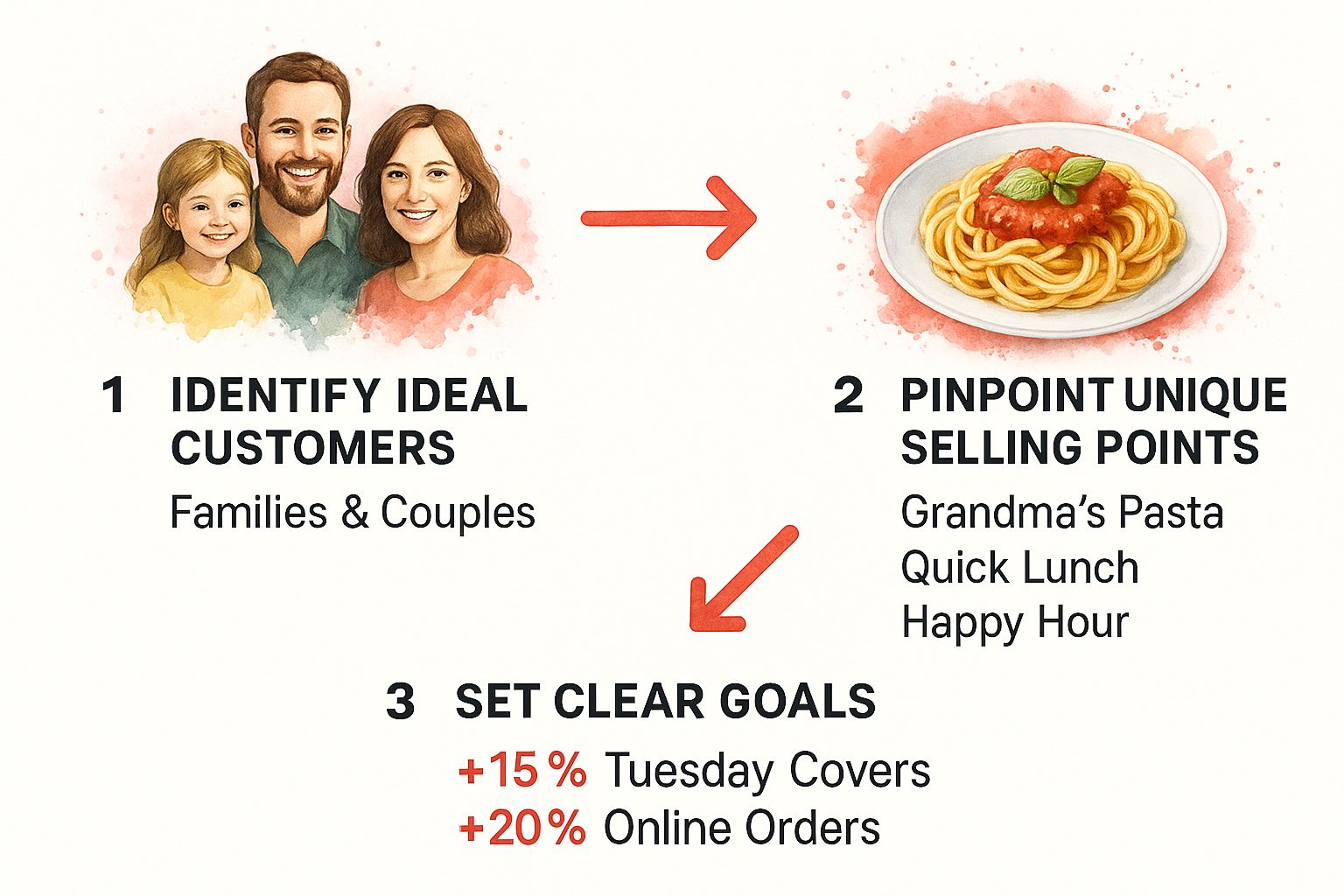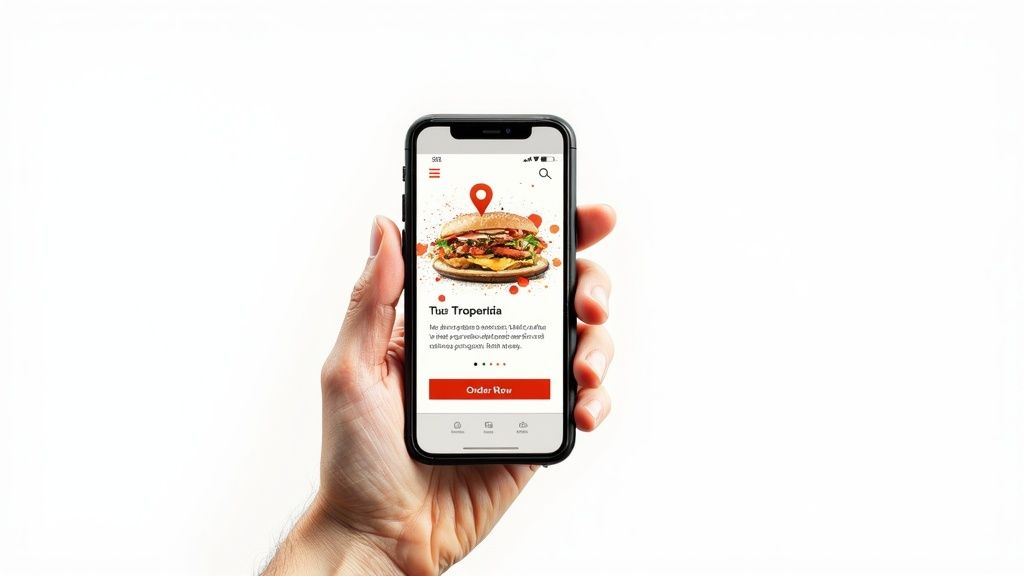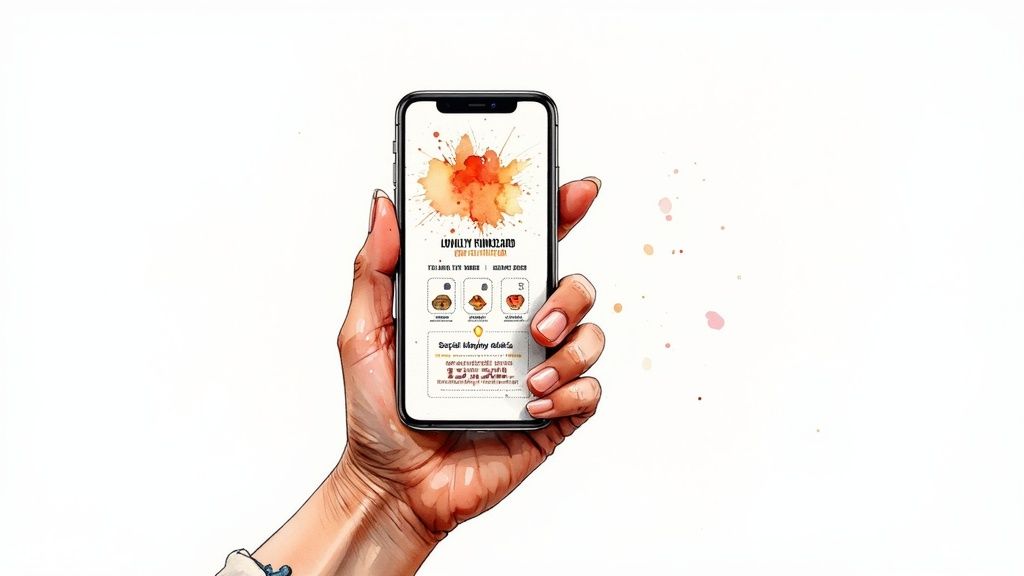Create a winning marketing plan for your restaurant with strategies to grow your revenue

A solid marketing plan for a restaurant isn't a binder of theories. It’s your roadmap for getting more people in the door and making them want to come back. It boils down to two things: knowing who you're serving and what makes you special.
Get this right, and marketing stops being a guessing game.
Before you spend a dollar on ads, get clear on the fundamentals. Who is your ideal customer? Go beyond age and income. Are they busy families needing a quick weeknight meal? Or couples looking for a special occasion spot?
Next, what’s your unique selling proposition (USP)? This is your edge. Is it your grandmother’s authentic pasta recipe, your lightning-fast lunch service, or your unbeatable happy hour specials? This is the difference between shouting into the void and speaking directly to your future regulars.
A great marketing plan doesn't just sell food; it sells an experience. It tells the story of why your restaurant is the perfect choice for a specific person.
As you start, understand the essential elements of a successful digital marketing strategy that will shape your efforts.

This process ensures every marketing dollar is tied to a clear business objective, making it easier to track success.
Here’s a quick rundown of the essential building blocks for your marketing plan.
Once your foundation is solid, set clear, realistic goals. Forget vague targets like "get more customers." Focus on specific outcomes you can measure.
Goals like these give you a benchmark to measure against, so you can double down on what’s working and ditch what isn't.
These days, your restaurant’s real front door is online. Before anyone walks in, they check you out on their phone. Your website and local search presence are the foundation for attracting new customers.
Think of your website as your digital hostess stand. Is it mobile-friendly? Can they find your menu, address, and hours in under five seconds? A clunky site sends them straight to a competitor. It must be clean, simple, and optimized to get people to decide to eat at your place. Solutions like Peppr Grow give restaurants a modern website that checks all these boxes.

The real battle is won in local search. This is how you appear when someone searches "tacos near me."
Your most powerful tool is your Google Business Profile (GBP). It's free and powers your appearance in Google Maps and local search results. Neglecting it is leaving cash on the table.
Your Google Business Profile isn't just a listing; it's an interactive storefront. It’s often the first and only impression a potential customer will have.
Treat your GBP with the same care as your physical space. A complete, active profile signals relevance to Google, boosting your rank.
Getting this right is straightforward but requires consistent attention. It’s a high-return activity in any digital restaurant marketing playbook.
Here’s your quick-win checklist:
Mastering these steps can also be supported by expert Search Engine Optimization (SEO) services. By nailing the basics, you capture local customers ready to spend.
Running social media for your restaurant can feel like a full-time job. But it's your most direct line to building a real community.
The goal is consistency, not burnout. You don't need to be on every platform. Pick two key channels where your customers are and focus on creating content that appeals to them.
Don't spread yourself too thin. Juggling multiple platforms leads to generic content. Focus your effort where it counts.
For most independent restaurants, mastering these two platforms is enough to drive serious business.
Your food is the star, but not the whole story. People connect with the people behind a business. Mix up your content to build a real bond.
Your social media should feel like an extension of your hospitality. What makes your restaurant unique? Your tight-knit kitchen crew? Your building's history?
A simple, effective content mix:
Consistency matters more than frequency. A frantic week of posts followed by a month of silence gets you nowhere. Build a simple, repeatable schedule.
A practical starting point:
This manageable approach keeps your profiles active and turns online buzz into real customers.
You need to give people a reason to walk through your doors. A smart promotion is a surgical tool designed to fix a specific problem, not just a discount.
A "20% off" sign might fill seats, but it often kills margins and attracts one-time bargain hunters. The goal is to create targeted offers that drive revenue when and where you need it most.

Stop thinking in generic discounts and start problem-solving. Every promotion needs a "why."
Here’s what that looks like:
This strategic mindset turns promotions from a cost into a revenue driver.
Promotions get new faces in the door; loyalty programs keep them coming back. You don't need a complex system. The best programs are simple and make regulars feel appreciated.
A loyalty program isn't just about rewarding spending; it's about recognizing your regulars. It’s your most powerful tool for turning a first-time guest into an advocate.
This year, 98% of restaurant leaders are expected to use discounts, and half of all customers now expect them. Since 73% of managers also plan to raise prices, a loyalty program bridges that gap by rewarding repeat business instead of one-off discounts.
A simple digital punch card or a points-based system through your POS can work wonders.
Your marketing plan isn't a "set it and forget it" document. It's a living roadmap. You don’t need to drown in spreadsheets. Track a few key numbers that directly impact your bottom line.
Focus on what moves the needle: reservations from your Google Business Profile or the redemption rate of an email coupon. These metrics tell you if your marketing is putting butts in seats. A simple monthly check-in is all you need. Ask two questions: What worked? What didn't?
This is a focused, 30-minute review to keep your plan on track. Double down on winners and cut losers before they waste more time and cash.
Vital signs to monitor:
A marketing plan without measurement is just a list of expensive hopes. Tracking turns hopes into a predictable growth strategy.
The restaurant world changes fast. While overall industry sales growth has cooled to around 2.8%, certain segments are thriving. Chicken concepts are projected to grow 6.9% and Mexican restaurants by 6.2%. A one-size-fits-all approach doesn't work. Tailor your plan to your category and local market. You can explore more restaurant industry sales forecasts to stay informed.
This constant process of measuring and adapting ensures your marketing dollars work as hard as you do. It turns your plan from a static document into a powerful tool.
Here are straight answers to common questions from restaurant owners.
A good rule of thumb is 3-6% of your total revenue. If you're launching or rebranding, you might want to increase that for a few months. But ROI is more important than the percentage. It's better to invest in two or three high-impact channels you can track, like your Google Business Profile and targeted local ads. If a $200 ad campaign brings in over $1,000 in orders, that’s a win. If not, move the money elsewhere.
When cash is tight, get scrappy. Focus on free and low-cost tools that hit your local audience hard.
Three things you can do with more hustle than cash:
The best marketing on a shoestring budget turns happy customers into your best salespeople. Getting them to advocate for you is the highest-ROI thing you can do.
It depends. Targeted Facebook or Instagram ads can bring in orders within a week. But building local SEO or a genuine social media following takes more patience—expect measurable progress in 60-90 days of consistent work. The key is consistency. A steady effort over months will always beat short, intense campaigns followed by silence.
You need both, but be obsessed with keeping the customers you have.
It can cost up to five times more to get a new person in the door than to convince a regular to come back. Your marketing plan should reflect that. Use local SEO and digital ads to attract new faces, but put serious energy into retention.
A great marketing plan is only as good as the tools you have to execute it. Peppr gives you everything you need to drive sales, manage your online reputation, and build customer loyalty, all from one place. See how our solutions can help.
